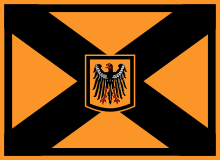- Ministry of the Reichswehr
-
In the history of Germany, the Ministry of the Reichswehr (German: Reichswehrministerium) was the defence ministry of the Weimar Republic and the early Third Reich. The 1919 Weimar Constitution provided for a unified, national ministry of defence to coordinate the new Reichswehr, and that ministry was set up in October 1919, from the existing Prussian War Ministry and Reichsmarineamt. It was based in the Bendlerblock building. The Wehrgesetz (Defence Law) of 21 May 1935[1] renamed it the Reichskriegsministerium (Reich War Ministry), which was then abolished in 1938 and replaced with the Oberkommando der Wehrmacht.
Contents
History
Within the framework of the Gesetzes über die Bildung einer vorläufigen Reichswehr ("Law on the formation of a provisional national-army") of March 1919, the Reichspräsident was commander-in-chief of the armed forces, with the Reichswehrminister (Defence Minister) exercising command. These arrangements left out the Prussian armed forces, which remained under the command of the Prussian Minister of War. After the Weimar Constitution came into force, the war ministries of Ländes of Bavaria, Saxony, Württemberg and Prussia were dissolved and command authority was concentrated in the hand of the national Reichswehrminister. Power of command for each branch was given to the head of the Army Command (Heeresleitung) and the head of the Naval Command (Marineleitung). The Ministeramt was established as a third office within the ministry in 1929, with the Ministeramt′s head acting as the Reichswehrminister′s political deputy. The general staff took over the role of the Truppenamt.
The "Verkündung der Wehrhoheit" (proclamation of military sovereignty) of 1935 created a new Oberkommando der Luftwaffe (OKL - dealt with by the Air Ministry) and turned the Heeresleitung into the Oberkommando des Heeres (OKH) and the Marineleitung into the Oberkommando der Marine (OKM). The minister was renamed the Wehrmachtsamt. As a result of the Blomberg-Fritsch Affair, the Reichskriegsminister and Wehrmachtsamt were abolished by Adolf Hitler and their duties transferred to the Oberkommando der Wehrmacht (OKW). From 1944, Germany′s Defence Ministry was known as the Reichsministerium für Rüstung und Kriegsproduktion ("Reich Ministry for Armaments and War Production"), alongside the Heeres-Waffenamt under Albert Speer.
Lists of officials
Defence Ministers
Name Began Ended Party Gustav Noske 13 February 1919 22 March 1920 SPD Otto Geßler 27 March 1920 19 January 1928 DDP Wilhelm Groener 20 January 1928 30 May 1932 Independent Kurt von Schleicher 1 June 1932 28 January 1933 Independent Werner von Blomberg 30 January 1933 27 January 1938 Independent (De facto) Wilhelm Keitel (as Chef des Oberkommando der Wehrmacht or OKW) 4 February 1938 8 May 1945 Independent Heads of the Army Command
German: Chefs der Heeresleitung
- Generalmajor Walther Reinhardt --- 13 September 1919-March 1920
- Generalmajor Hans von Seeckt --- March 1920-October 1926
- Generalleutnant Wilhelm Heye --- October 1926-31 October 1930
- General der Infanterie Kurt von Hammerstein-Equord --- 1 November 1930-27 December 1933
- Generalleutnant Werner Freiherr von Fritsch --- 1 January 1934-1 June 1935
Oberbefehlshaber des Heeres
- General der Artillerie Werner Freiherr von Fritsch --- 1 June 1935-4 February 1938
German: Chef der Marineleitung
- Vizeadmiral Adolf von Trotha --- September 1919-March 1920
- Konteradmiral William Michaelis --- March-September 1920 (kommissar)
- Vizeadmiral Paul Behncke --- 1 September 1920-30 September 1924
- Vizeadmiral Hans Zenker --- 1 October 1924-30 September 1928
- Vizeadmiral Erich Raeder --- 1 October 1928-1 June 1935
Oberbefehlshaber der Marine
- Admiral Erich Raeder --- 1 June 1935-30 January 1943
Heads of the Ministeramts
- Generalleutnant Kurt von Schleicher --- 1 February 1929-1 June 1932
- Generalmajor Ferdinand von Bredow --- 1 June 1932-30 January 1933
- Oberst Walter von Reichenau --- 1 February 1933-1 February 1934
Chef des Wehrmachtamtes
- Generalmajor Walter von Reichenau --- 1 February 1934-30 September 1935
- Generalmajor Wilhelm Keitel --- 1 October 1935-4 February 1938
Chef des Oberkommandos der Wehrmacht (OKW)
- General der Artillerie Wilhelm Keitel --- 4 February 1938-8 May 1945
References
- ^ (German) RGBl I, S. 609 / Faksimile Wehrgesetz
External links
- (German) Article on adlexikon.de
Categories:- Defence ministries
- Reichswehr
Wikimedia Foundation. 2010.



